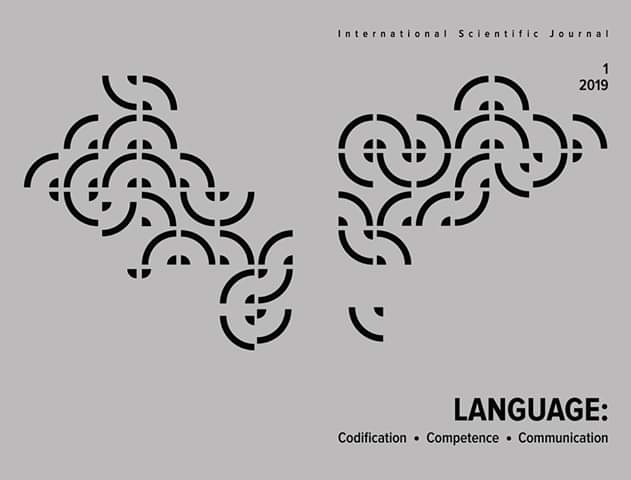COMPARATIVE ANALYSIS OF THE UKRAINIAN AND ARABIC PHONEMIC SYSTEMS
DOI:
https://doi.org/10.24025/2707-0573.1.2019.169499Abstract
Background During the study of the Ukrainian language by students of other nationalities, the mechanism of interlingual phonetic interference works, which affects the quality of the phonetic expression of the pronunciation in the non-native (Ukrainian) language. Since the acquisition of the phonetic base of the Ukrainian language and, as a result, the correct pronunciation depend on the degree of interlingual phonetic interference, there is a need for the national orientation of teaching Ukrainian pronunciation as a means of its individualization and increasing efficiency, because in each case the interaction of the native and Ukrainian languages has a specific individual character.
Purpose. A comparative analysis of the phonemic system of the Ukrainian and Arabic languages in order to predict possible violations of Ukrainian Orthophysics by Arab students.
Methods: scientific-methodical analysis and synthesis, retrospective-historical analysis of scientific and scientific-methodical literature, comparative analysis of phonetic and orphoetic phenomena of Ukrainian and Arabic languages.
Results. A comparative analysis of the phonemic system of the Ukrainian and Arabic languages suggests that the assimilation of the orthoepy of the foreign pronunciation is based on a certain level of development of pronunciation of the phonemes of the native language. Reliance on the mother tongue gives both positive results and negative ones, so we regard the transfer of certain skills from the mother tongue to an objective reality. Conditionally all skills can be divided into 3 groups:
- skills of pronunciation of the native language, which should be transferred to the new speech material and updated;
- skills that were previously formed in the element of the native language and when mastered by another pronunciation should be corrected;
- skills that are absent in the native language and must be re-formed.
Discussion. The solution of the methodological tasks of teaching the pronunciation is based on a conscious assimilation of new articulation movements, methods of combining sounds, rhythmic and intonational formulation of words, phrases, texts by comparison with similar phenomena of the native language.
Keywords: phonetic interference, phonetic disturbances, loud phonemes, consonant phonemes.
References
Аль–Кудмани Р. (1980). Сопоставление консонантных систем русского и арабского языков в целях прогнозирования явлений интерференции в русской речи арабов. Автореф. дис. канд. филол. наук : 10.02.00. Москва.
Ванрайх У. (1979). Языковые контакты. Киев: Вища школа.
Василенко Н.В. (2008). Формування орфоепічних умінь і навичок з української мови у арабськомовних студентів. Дис... канд. пед. наук: 13.00.02. Київ.
Гранде Б.М. (1998). Введение в сравнительное изучение семитских языков. Москва: Восточная литература.
Ковалёв А.А. (2000). Учебник арабского языка. Москва: Восточная литература.
Костомаров В.Г. (1979). Методика как наука. Статья вторая: методическая проблема двуязычия. Русский язык за рубежом, 6, 67–73.
Любимова Н.А. (1985). Фонетическая интерференция. Ленинград.: ЛГУ.
Реформатский А.А. (1962). О сопоставительном методе. Русский язык в национальной школе, 5, 23–24.
Совсун Г.В. (1990). Арабский акцент в русском языке на уровне звукоупотребления. Вопросы обучения русскому произношению студенто-иностранцев, 3–12.
Тамам Хасан (1979). Пошуки в арабській мові. Каїр: Аль-Жадіда.
Халидов Б.Э. (1965). Учебник арабского языка. Ташкент: Учитель.
Хауген Э. (1972). Проблемы двуязычного описания. Новое в лингвистике, 8, 277–289.
Downloads
Published
Issue
Section
License
Copyright (c) 2019 Language: codification, competence, communication

This work is licensed under a Creative Commons Attribution-NonCommercial 4.0 International License.
Authors hold full copyright and at the same time they transfer the publishing rights to the journal. The author of a published article has the right to distribute it, post the work in the electronic repository of his/her institution, publish as a part of a monograph, etc. with a required link to the place (output) of its first publication.
The authors confirm that the scientific article submitted for publication has not previously been published and has not been submitted to the editorial office of other journals.
If you have any questions, please contact us:
email: ukrmova@chdtu.edu.ua, o.pchelintseva@chdtu.edu.ua
Viber / WhatsApp: +38 093 789 09 27


